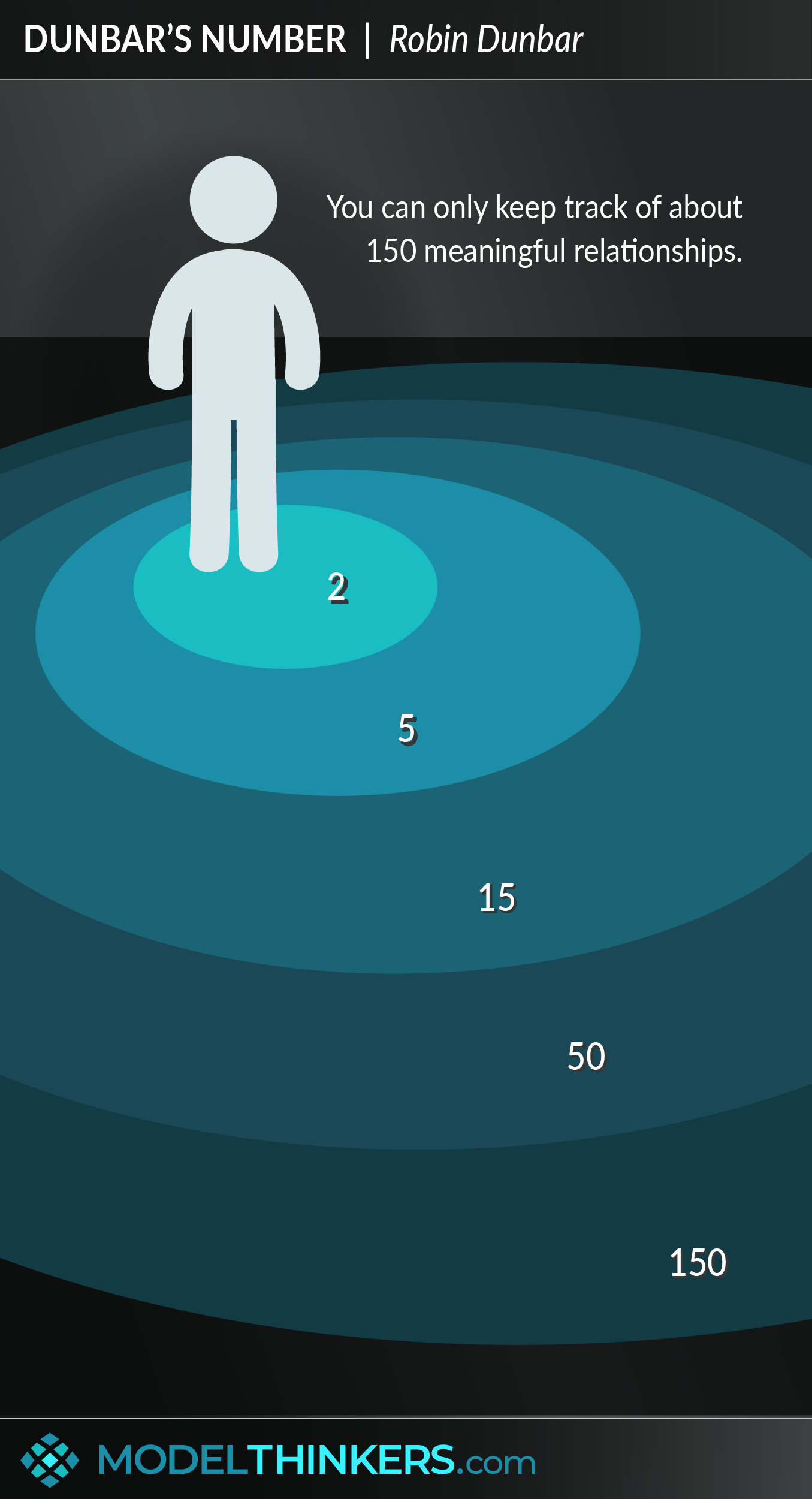

 0 saved
0 saved
 36.7K views
36.7K views








Is building that social media following just not filling your soul with joy? Want to be happier with the optimum number of relationships? Or perhaps you're wanting to launch a community, run a group, or structure a company? If you ticked any of the above, it might be worth experimenting with Dunbar's Number.
In its simplest form, Dunbar’s Number states that you can only keep track of a maximum of 150 meaningful relationships.
BEYOND THE RULE OF 150.
Also known as ‘The Rule of 150’, this has become the main takeaway for most. However, Dunbar actually discussed a range of 100 to 200 as an optimum number of meaningful relationships and put forward a series of nested numbers beyond that:
- 1 or 2 special friends.
- 5 close friends.
- 15 good friends.
- 50 friends
- 150 meaningful relationships
- 500 acquaintances.
Dunbar proposed all of these numbers as ranges — with extroverts pushing beyond the average and introverts tending to be on the lower end. Also, according to Dunbar, the specific people in the bands will tend to change while the numbers will tend to remain consistent. That said, there has been considerable criticism of this thinking, some positing alternative numbers others challenging that any such universal numbers apply. See Limitations below for more.
A RANGE OF CONTEXTS.
Dunbar and his supporters argue that this model has played out in diverse settings including offices, communes, clubs, social networks, military organisations, and even a study of Christmas card lists. With each context, Dunbar argues that going beyond 150 leads to a lack of cohesion and reduces the life span of the group as a result. While many groups will remain larger than 150 Dunbar argues that to achieve longevity, those groups will develop communities of more meaningful connections, reflecting his numbers.
APPLICATIONS.
Use Dunbar’s Number to avoid alienation by maintaining meaningful social contacts and seeking out solid 'circles' of connection within society and organisations alike. More broadly, use it to inform the design of communities, movements and social networks in your business and life.
The final application of this approach is in relation to building friendships. Beyond the numbers, Dunbar's advice is to seek out the combination of endorphin release and icebreakers that are provided by singing clubs — see the Actionable Takeaways below for more.




- Design communities accordingly.
Consider Dunbar’s Numbers in your community design, whether it be linked to interests, business, or other organisations. Consider how to support connections at the recommended levels to provide a ‘layered’ experience among high numbers of people. For example, initiate pods or teams in larger groups.
- Choose your relationships wisely
Your life is shaped by the quality of your relationships. Dunbar often argues that these relationships will inform health, attitudes and even risk of divorce and death. Maintain relationships with people who have a positive influence on your life and give up those who cause stress.
- Ensure diversity in your network
People are not just contacts, but solutions to potential issues and sources of new ideas. Similar to the idea of building a diverse Latticework of Mental Models, having people from various backgrounds and with various interests in your network gives you access to a large, dynamic pool of thought and support.
- Join a singing club.
Yes, we said singing club. Of a number of clubs that Dunbar studied, he claims that the combination of endorphin release and ‘icebreaker effects’ made singing clubs the most effective means to create a sense of belonging and community. Though he found similar results in other active groups such as dancers and rowers.
Dunbar's premise has come under some criticism — as he started his research based on a correlation between primate brain size and their associated social group size. People have pointed out that brain size alone has not been a consistent predictor of the ability to develop social relationships, particularly in insects.
The numbers have also been criticised with the rise of online social networks which, some argue, have either multiplied Dunbar’s Numbers and/or made them obsolete. Dunbar counters this with metrics from Facebook and other social media sites that add credence to his approach. Interestingly, Dunbar has recently posited that the impact of social media might be to reduce the numbers in his model over time.
A persistent argument against this model relates to potential Confirmation Bias — that these numbers were established as a hypothesis and then studies reinforced them rather than tested them. Indeed this recent Swedish study challenged many aspects of Dunbar's work and that we can identify any such universal number.
Finally, rather than dismissing the broad approach, other anthropologists have argued for alternative numbers as optimal for social relations, including 290 put forward by Russel Bernard et al.
Legal firm applies trial and error to arrive at 150.
In Malcolm Gladwell’s book Tipping Point, he describes how the company behind the Gore-Tex brand allowed a maximum of 150 employees in one building after discovering that social problems start to occur when this number is exceeded.
Swedish tax authority.
The Swedish tax authority reorganised their function in 2007 based on Dunbar’s research. Restricting numbers to 150 people per office.
Dunbar’s number provide guidance for those wanting meaningful connection and those wanting to design communities and/or events.
Use the following examples of connected and complementary models to weave Dunbar’s number into your broader latticework of mental models. Alternatively, discover your own connections by exploring the category list above.
Connected models:
- Cialidini’s six principles of influence: in creating greater influence within a community.
- Non violent communication: in forming connected meaningful relationships.
Complementary models:
- Hanlon’s razor: to maintain healthy relationships even when annoyed.
- Compounding: perhaps challenging this mental model in a social context.
- Lock-in effect: when considering community as a way to secure loyalty.
This cognitive limit was proposed in the 1990s by British anthropologist Robin Dunbar after studying primates and their grooming behaviour. Dunbar gave an informal definition of the concept as ‘the number of people you would not feel embarrassed about joining uninvited for a drink if you happened to bump into them in a bar’.
Discover more about Dunbar’s Number by reading the British anthropologist’s book How Many Friends Does One Person Need?: Dunbar's Number and Other Evolutionary Quirks.
Watch Robin Dunbar giving a TEDx talk on how the use of the internet influences the number of relationships you can maintain.
 My Notes
My Notes
Oops, That’s Members’ Only!
Fortunately, it only costs US$5/month to Join ModelThinkers and access everything so that you can rapidly discover, learn, and apply the world’s most powerful ideas.
ModelThinkers membership at a glance:






“Yeah, we hate pop ups too. But we wanted to let you know that, with ModelThinkers, we’re making it easier for you to adapt, innovate and create value. We hope you’ll join us and the growing community of ModelThinkers today.”




















































































